Analysis of the Temporal and Spatial Characteristics of Material Cultural Heritage Driven by Big Data—Take Museum Relics as an Example
Abstract
1. Introduction
2. Related Work
3. Materials and Methods
3.1. Materials
3.2. Methods
3.2.1. Continuity and Intermittentness
3.2.2. Standard Deviation Ellipse
3.2.3. Cosine Similarity
3.2.4. PageRank
4. Results and Discussion
4.1. General Characteristics of Cultural Relics
4.2. Temporal Characteristics of Cultural Relics
4.2.1. Continuity and Intermittentness
- “Life Cycle” of Cultural Relics
- 2.
- Discrimination of continuity and intermittentness
- 3.
- Background interpretation of continuity and intermittentness
4.2.2. Similarity
4.3. Regional Characteristics of Cultural Relics
4.3.1. Aggregation and Migration
- 4.
- “Cultural Communication Circle”
- 5.
- Significance discrimination of nodes in the “cultural communication circle”
- 6.
- The mobility of weapons as cultural relics
4.3.2. Similarity
4.4. Discussion
5. Conclusions
Author Contributions
Funding
Institutional Review Board Statement
Informed Consent Statement
Data Availability Statement
Conflicts of Interest
Appendix A
| Province Name | Abbreviation | Category Name | Abbreviation | Dynasty Name | Abbreviation |
|---|---|---|---|---|---|
| Anhui | AH | jade, gems | YSQ | Xia Dynasty | Xia |
| Beijing | BJ | pottery | TQ | Shang Dynasty | Shang |
| Chongqing | CQ | porcelain | CQ | Zhou Dynasty | Zhou |
| Fujian | FJ: | bronze | BR | Qin Dynasty | Qin |
| Gansu | GS | gold and silverware | JYQ | Han Dynasty | Han |
| Guangdong province, | GD | ironware, other metalware | IM | The Three Kingdoms period | SanG |
| Guangxi Autonomous Region | GX | lacquerware | Jin Dynasty | JC | |
| Guizhou | GZ | sculpture | DS | The Sixteen | SLG |
| Hainan | HN | stone tools, stone carvings, bricks and tiles | SQ | Northern and Southern Dynasties | NBC |
| Hebei | HEB | calligraphy, painting | SF, | Sui Dynasty | Sui |
| Henan | The HEN | stationery | WJ | Tang Dynasty | Tang |
| Heilongjiang | HLJ | oracle | JG | Five dynasties and Ten states | WD |
| Hubei | HB | seal talisman | XY | Song Dynasty | Song |
| Hunan | HN | coin | QB | The Center | Liao |
| Jilin | JL | angular apparatus | YG | Xixia | XiX |
| Jiangsu | JS | bamboo wood carving | ZMD | Jin Dynasty | Jin |
| Jiangxi | JX | furniture | JJ | Yuan Dynasty | Yuan |
| Liaoning | LN | enamelware | FL | Ming Dynasty | Ming |
| Neimenggu | NM | embroidery | ZX | Qing Dynasty | Qing |
| Ningxia Autonomous Region | NX | ancient books | GJ | Republic of China | MG |
| Qinghai | QH | rubbings of rubbings | BT | People’s Republic of China | GHG |
| Shandong | SD | arms | WQ | ||
| Shanxi | SX | stamps | YP | ||
| Shanxi | ShX | documents, promotional materials | WJX | ||
| Shanghai | SH | archival documents | DA | ||
| Sichuan | SC | celebrity relics | MR | ||
| Tianjin | TJ | glassware | BLQ | ||
| Xinjiang | XZ | musical instruments | YQ | ||
| Xinjiang | XJ | leather | PG | ||
| Yunnan | YN | audiovisual products | YX | ||
| Zhejiang | ZJ | bill | PJ | ||
| transportation | JT | ||||
| weights and measures | DL | ||||
| specimen, fossils | BB | ||||
| other | others |
References
- Janković, R. Machine learning models for cultural heritage image classification: Comparison based on attribute selection. Information 2020, 11, 12. [Google Scholar] [CrossRef]
- Ronchi, A.M. eCulture: Cultural Content in the Digital Age; Springer: Berlin/Heidelberg, Germany, 2009. [Google Scholar]
- Zhengshan, L. The Significance of the Regulations on Museum and the Future of Museums. China Cult. Herit. Entific Res. 2015, 2, 1–5. [Google Scholar]
- Li, J.; Fang, H.; Underhill, A.P. The History of Perception and Protection of Cultural Heritage in China; Springer: Berlin/Heidelberg, Germany, 2016. [Google Scholar]
- Qingwen, M. Responding to common questions on the conservation of agricultural heritage systems in China. Acta Geogr. Sin. (Engl. Ed.) 2016, 26, 969–982. [Google Scholar]
- Altieri, M.A.; Koohafkan, P. Globally Important Ingenious Agricultural Heritage Systems (GIAHS): Extent, significance, and implications for development. In Proceedings of the Second International Workshop and Steering Committee Meeting for the Globally Important Agricultural Heritage Systems (GIAHS) Project; FAO: Rome, Italy, 2004; pp. 7–9. [Google Scholar]
- Zheng, S. Reflections on Architectural Heritage Conservation in Shanghai. Built Herit. 2017, 1, 1–13. [Google Scholar] [CrossRef]
- Mei, Q. Constructing New Meanings of Chinese Architectural Heritage in the World Heritage Sites of Malacca Straits. Built Herit. 2017, 1, 26–35. [Google Scholar] [CrossRef]
- Li, W.; Lin, L.U.; Shi-Rong, T.; Song, L.U.; Zhao, Y.; Yong, W.; Dong-Dong, L. Residents’ attitudes to tourism development in ancient village resorts. Chin. Geogr. Sci. 2004, 14, 170–178. [Google Scholar]
- Zhao, G.; Deng, Z.; Shen, J.; Ryan, C.; Gong, J. Carrying capacity and its implications in a Chinese ancient village: The case of Hongcun. Asia Pac. J. Tour. Res. 2018, 23, 260–280. [Google Scholar] [CrossRef]
- Towers, G. Rediscovering rural Appalachian communities with historical GIS. Southeast. Geogr. 2010, 50, 58–82. [Google Scholar] [CrossRef]
- Knowles, A.K.; Hillier, A. Placing History: How Maps, Spatial Data, and GIS Are Changing Historical Scholarship (Review); ESRI, Inc.: Redlands, CA, USA, 2009. [Google Scholar]
- Hagge, P.D. Toward spatial humanities: Historical GIS & spatial history. Soc. Cult. Geogr. 2015, 17, 1–2. [Google Scholar]
- Duckett, B. A Companion to Museum Studies. Ref. Rev. 2007, 2, 10–11. [Google Scholar]
- De Wever, P.; Guiraud, M. Geoheritage and Museums; Elsevier: Amsterdam, The Netherlands, 2018; pp. 129–145. [Google Scholar]
- Wigan, M.R.; Clarke, R. Big Data’s Big Unintended Consequences. Computer 2013, 46, 46–53. [Google Scholar] [CrossRef]
- Bail, C.A. The cultural environment: Measuring culture with big data. Theory Soc. 2014, 43, 465–482. [Google Scholar] [CrossRef]
- Mclaughlin, T.R.; Whitehouse, N.J.; Schulting, R.J.; Mcclatchie, M.; Barratt, P.; Bogaard, A. The Changing Face of Neolithic and Bronze Age Ireland: A Big Data Approach to the Settlement and Burial Records. J. World Prehistory 2016, 29, 117–153. [Google Scholar] [CrossRef]
- Tian, T.; Ni, L. Problem of unequal authorities assignment based on pagerank algorithm. Jisuanji Gongcheng/Comput. Eng. 2007, 33, 53–55. [Google Scholar]
- Chloupek, B.R. Public memory and political street names in Koice: Slovakia’s multiethnic second city. J. Hist. Geogr. 2019, 64, 25–35. [Google Scholar] [CrossRef]
- Lili, J.; Qizhang, L.; Qingwen, Q.I.; Yanjun, Y.E.; Xun, L. The heritage and cultural values of ancient Chinese maps. Acta Geogr. Sin. (Engl. Ed. ) 2017, 27, 1521–1540. [Google Scholar]
- Huang, S. The geological heritages in Xinjiang, China: Its features and protection. J. Geogr. Sci. 2010, 20, 357–374. [Google Scholar] [CrossRef]
- Cheng, Q.; Ling, S. Geographical distribution and affecting factors of the intangible cultural heritage in China. Sci Geogr Sin 2013, 33, 1166–1172. [Google Scholar]
- Ruirui, L.; Wei, Z.; Jing, C. Structure and distribution of the intangible cultural heritage in Fujian. Areal Res. Dev. 2014, 33, 97–102. [Google Scholar]
- Chen, X.; Xie, W.; Li, H. The spatial evolution process, characteristics and driving factors of traditional villages from the perspective of the cultural ecosystem: A case study of Chengkan Village—ScienceDirect. Habitat Int. 2020, 104, 102250. [Google Scholar] [CrossRef]
- Kim, G.; Kang, W.; Park, C.R.; Lee, D. Factors of spatial distribution of Korean village groves and relevance to landscape conservation. Landsc. Urban Plan. 2018, 176, 30–37. [Google Scholar] [CrossRef]
- Matless, D. Properties of ancient landscape: The present prehistoric in twentieth-century Breckland. J. Hist. Geogr. 2008, 34, 68–93. [Google Scholar] [CrossRef]
- Nikolaou, P. Authoring the ancient sites of Cyprus in the late nineteenth century: The British Museum excavation notebooks, 1893–1896. J. Hist. Geogr. 2017, 56, 83–100. [Google Scholar] [CrossRef]
- Ren-zhi, H. Ancient city ruins in the deserts of the Inner Mongolia Autonomous Region of China. J. Hist. Geogr. 1985, 11, 241–252. [Google Scholar] [CrossRef]
- Stelian, M. Shifting urban namescapes: Street name politics and toponymic change in a Romanian(ised) city. J. Hist. Geogr. 2019, 65, 48–58. [Google Scholar]
- Ding, Y.; Ye, C.Y.; Ma, R.F. Evolution of Temporal and Spatial Distribution of Zhejiang’s Intangible Cultural Heritage and Its Influencing Factors. J. Sichuan Norm. Univ. (Soc. Sci. Ed.) 2016, 4, 61–66. [Google Scholar]
- Liu, D.J.; Hu, J.; Chen, J.; XV, X. The study of spatial distribution pattern of traditional villages in China. China Popul. Resour. Environ. 2014, 24, 157–162. [Google Scholar]
- Li, Z.; Zhu, C.; Wu, G.; Zheng, C.; Shao, S.; Feng, F.; Wang, N. Spatial and temporal distribution of prehistoric human sites and its driving factors in Henan Province. Acta Geogr. Sin. 2013, 68, 1527–1737. [Google Scholar]
- Wu, L.; Zhu, C.; Zheng, C. Response of prehistoric culture to climatic environmental changes since Holocene in Zhejiang, East China. Acta Geogr. Sin. 2012, 67, 903–916. [Google Scholar]
- Jboor, N.H.; Belhi, A.; Al-Ali, A.K.; Bouras, A.; Jaoua, A. Towards an Inpainting Framework for Visual Cultural Heritage. In Proceedings of the IEEE Jordan International Joint Conference on Electrical Engineering and Information Technology, Amman, Jordan, 9–11 April 2019. [Google Scholar]
- Yasser, A.; Clawson, K.; Bowerman, C.; Lévêque, M. Saving cultural heritage with digital make-believe: Machine learning and digital techniques to the rescue. In Proceedings of the HCI’17: Proceedings of the 31st British Computer Society Human Computer Interaction Conference, Nicosia, Cyprus, 31 October–5 November 2016; pp. 1–5. [Google Scholar]
- Llamas, J.; Lerones, P.M.; Zalama, E.; Gómez-García-Bermejo, J. Applying deep learning techniques to cultural heritage images within the inception project. In Proceedings of the Euro-Mediterranean Conference, Barcelona, Spain, 13 July 2016; pp. 25–32. [Google Scholar]
- Li, H.; Zhang, J.; Sun, J. A visual analytics approach for deterioration risk analysis of ancient frescoes. J. Vis. 2016, 19, 529–542. [Google Scholar] [CrossRef]
- Zhang, J.; Kang, K.; Liu, D.; Yuan, Y.; Yanli, E. Vis4Heritage: Visual Analytics Approach on Grotto Wall Painting Degradations. IEEE Trans. Vis. Comput. Graph. 2013, 19, 1982–1991. [Google Scholar] [CrossRef] [PubMed]
- Deufemia, V.; Paolino, L.; Tortora, G.; Traverso, A.; Mascardi, V.; Ancona, M.; Martelli, M.; Bianchi, N.; De Lumley, H. Investigative Analysis across Documents and Drawings: Visual Analytics for Archaeologists. In Proceedings of the International Working Conference on Advanced Visual Interfaces 2012, Capri Island, Italy, 22–26 May 2012. [Google Scholar]
- Yuill, R.S. The standard deviational ellipse; an updated tool for spatial description. Geogr. Ann. Ser. B Hum. Geogr. 1971, 53, 28–39. [Google Scholar] [CrossRef]
- Scott, L.M.; Janikas, M.V. Spatial statistics in ArcGIS. In Handbook of Applied Spatial Analysis; Springer: Berlin/Heidelberg, Germany, 2010; pp. 27–41. [Google Scholar]
- Muflikhah, L.; Baharudin, B. Document clustering using concept space and cosine similarity measurement. In Proceedings of the 2009 International Conference on Computer Technology and Development, Kota Kinabalu, Malaysia, 13–15 November 2009; pp. 58–62. [Google Scholar]
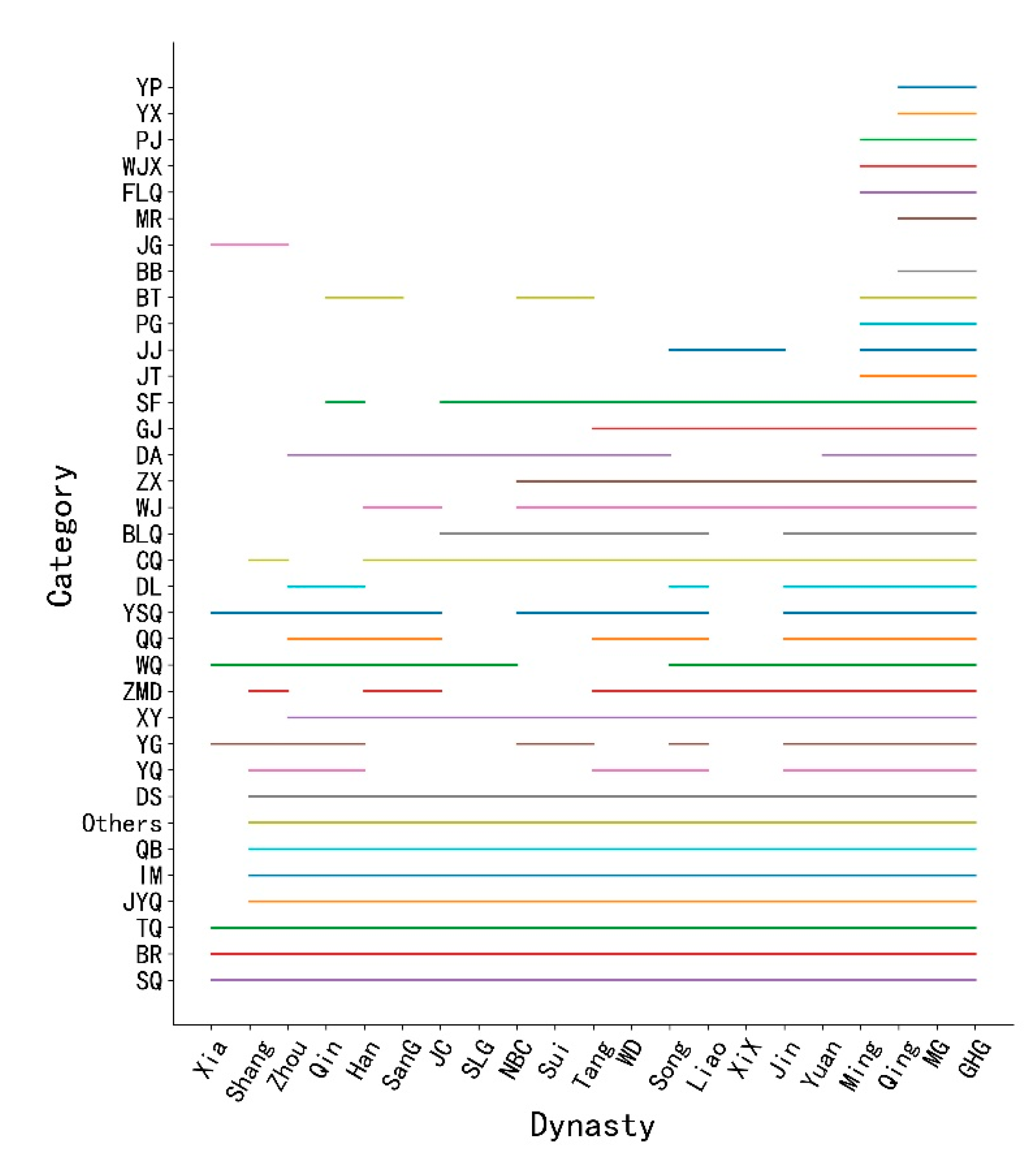
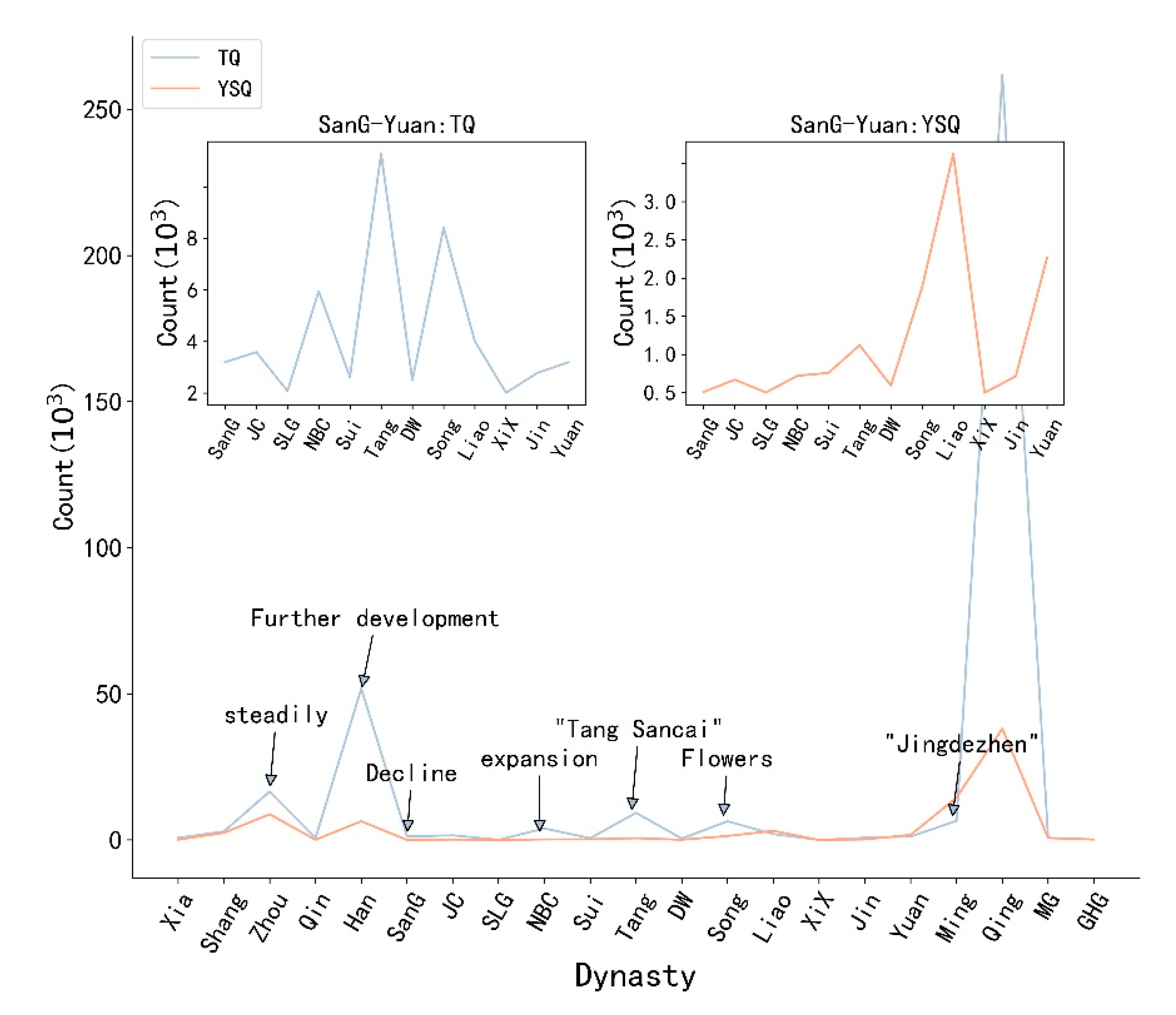
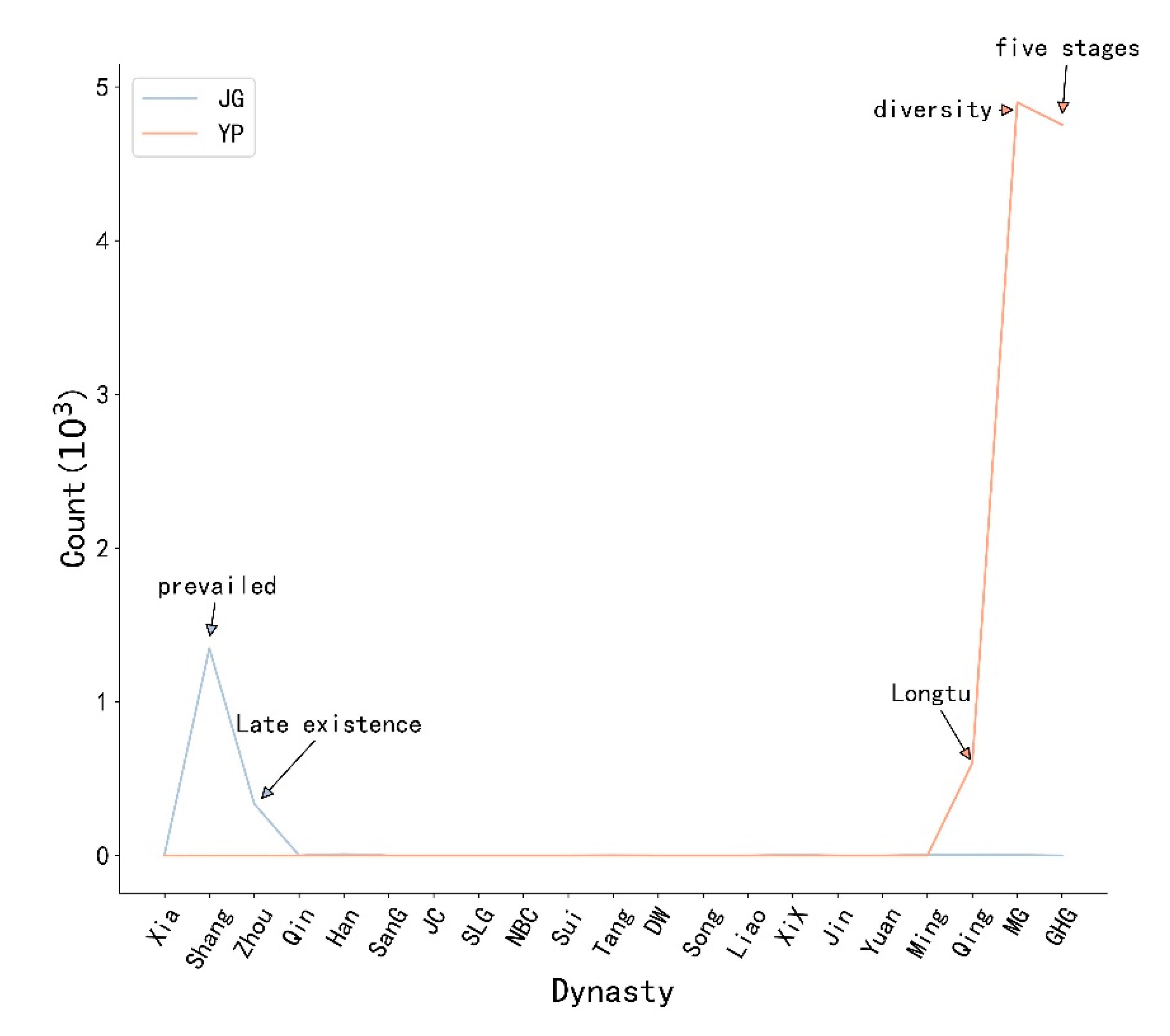
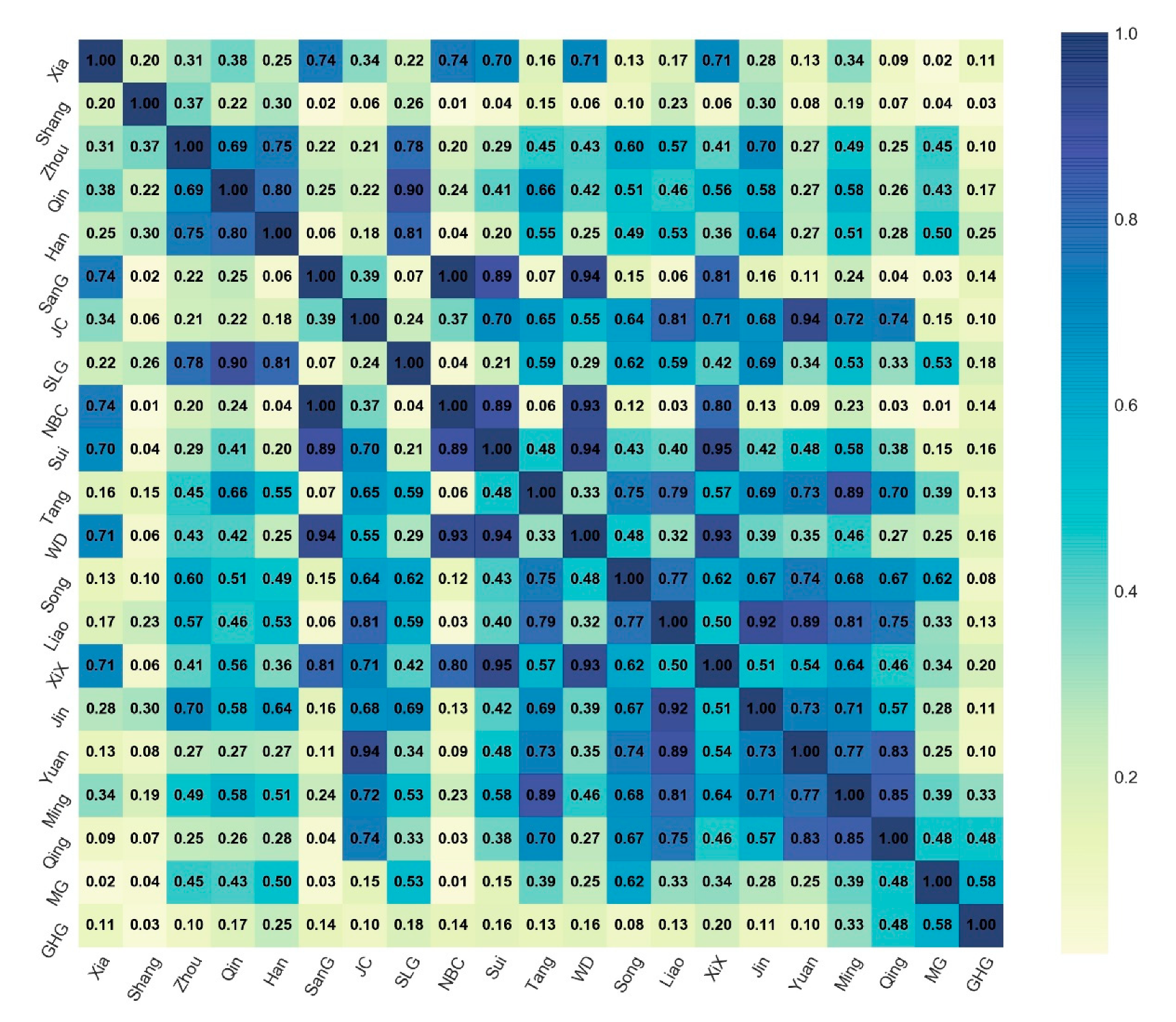
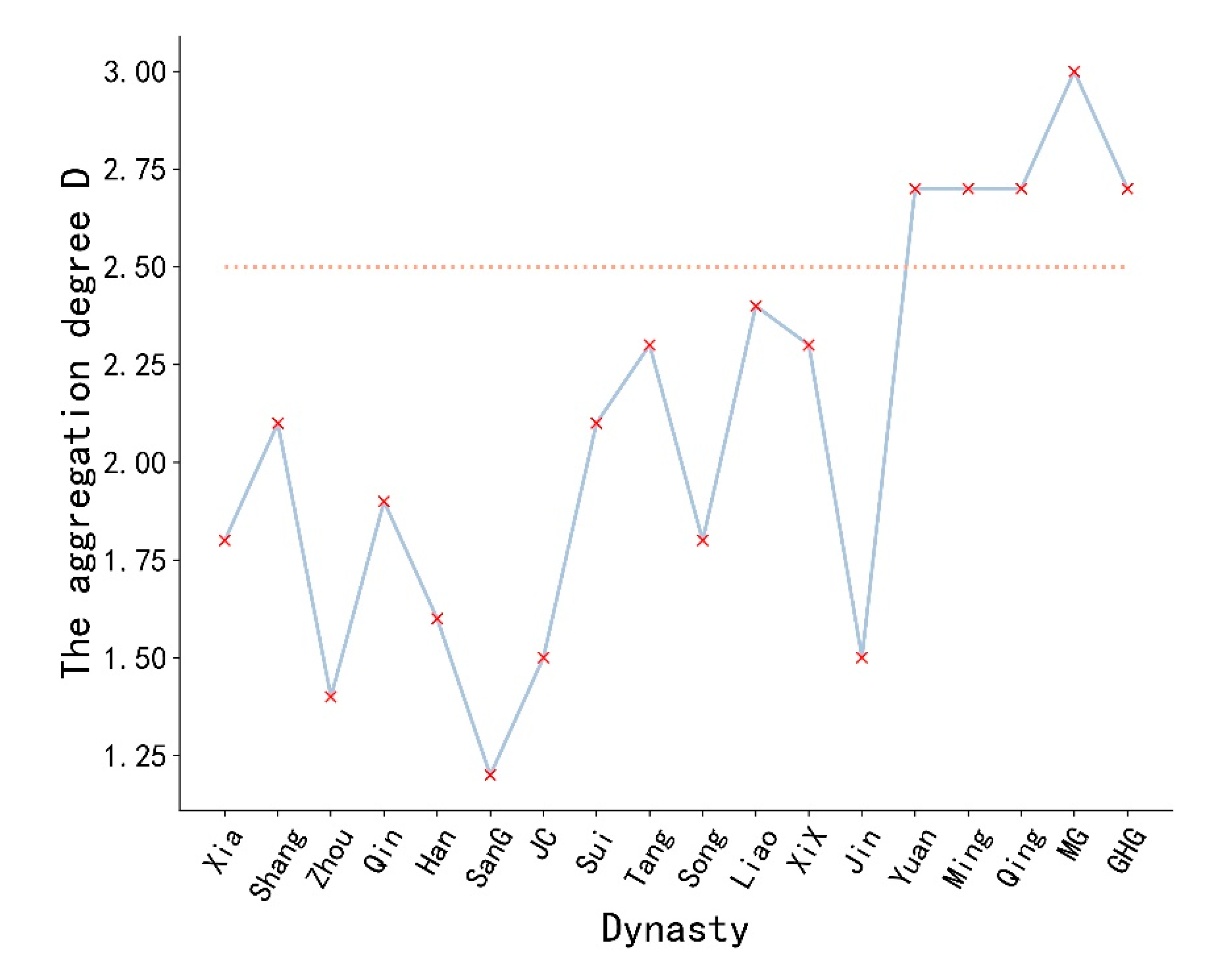


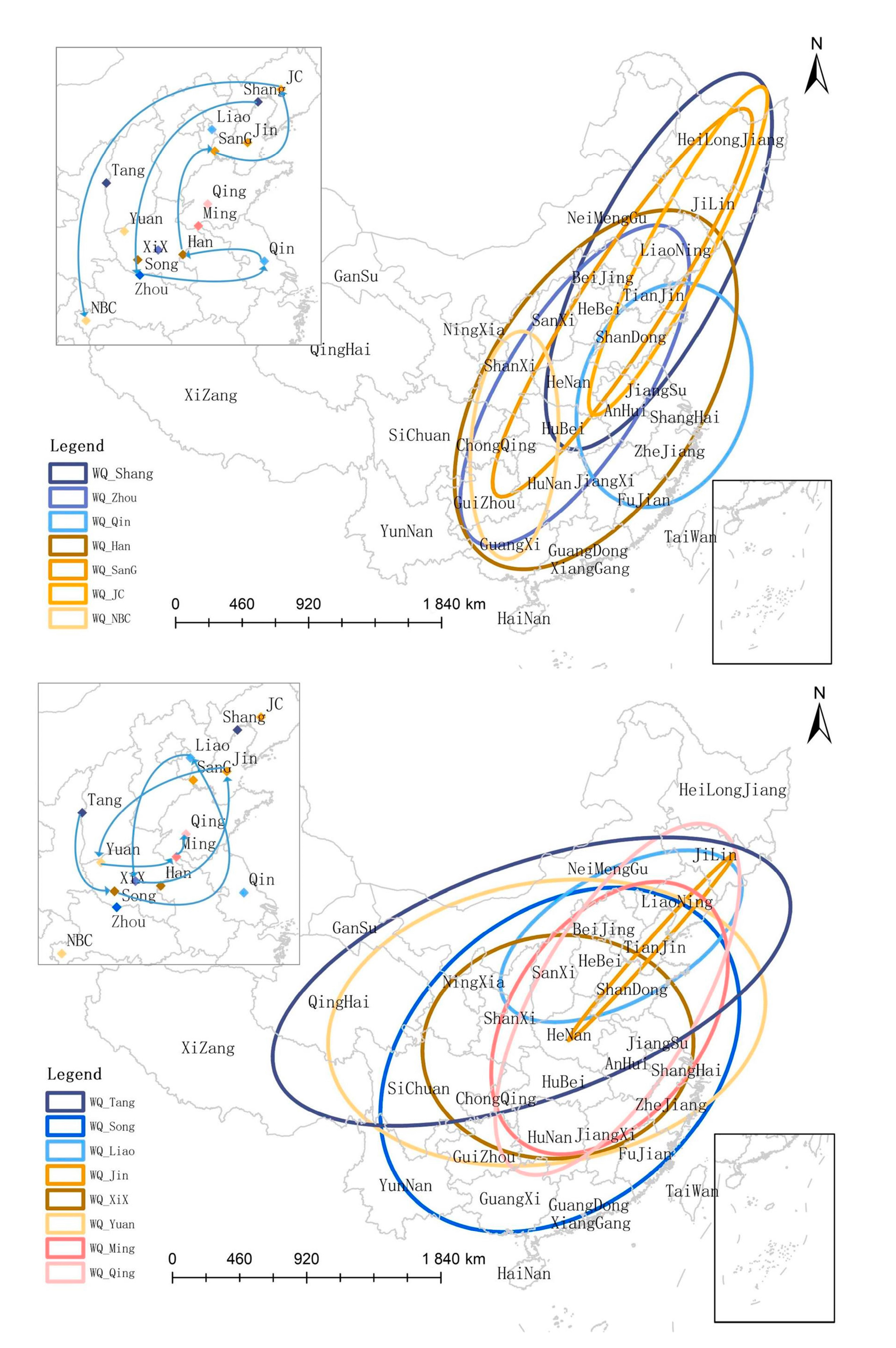
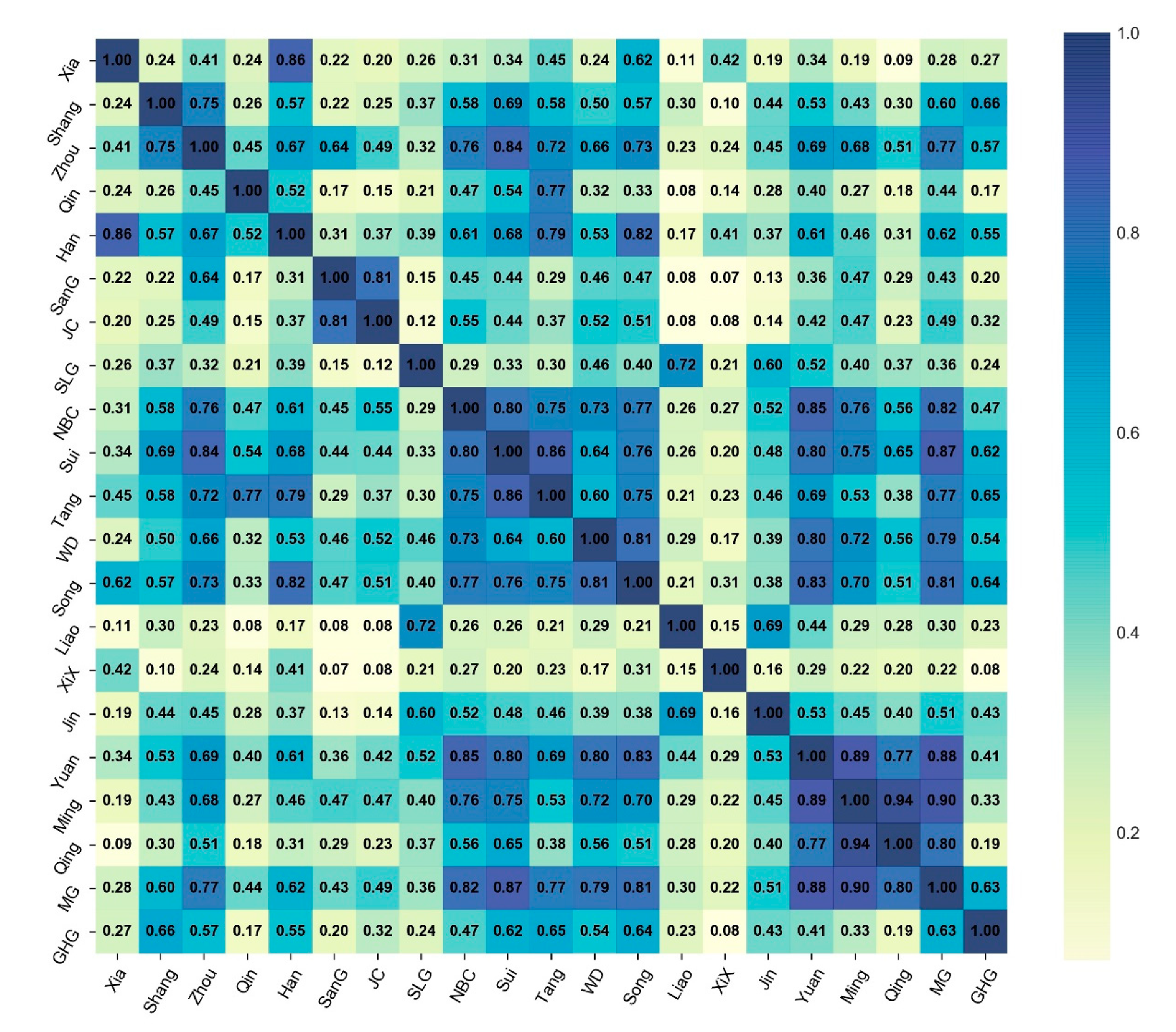
| Dynasty | The Total | Total Percentage (%) | Maximum Percentage of Category (%) | Largest Proportion of Districts (%) | Dynasty | The Total | Total Percentage (%) | Maximum Percentage of Category (%) | Largest Proportion of Districts (%) |
|---|---|---|---|---|---|---|---|---|---|
| Xia | 1139 | 0.06 | TQ: 65.5 | GS: 48.2 | WD | 8342 | 0.41 | QB: 38.7 | SC: 13.7 |
| Shang | 31,616 | 1.57 | JG: 42.6 | SX: 26.2 | Song | 164,223 | 8.16 | QB: 43.3 | HLJ: 14.6 |
| Zhou | 136,729 | 6.80 | BR: 31.4 | HB: 15.5 | Liao | 10,238 | 0.51 | CQ: 24.7 | LN: 34.4 |
| Qin | 6586 | 0.33 | QB: 17.4 | SH: 45.3 | XiX | 2375 | 0. 12 | CQ: 26.0 | NX: 45.5 |
| Han | 201,374 | 10.01 | TQ: 25.7 | GS: 23.2 | Jin | 16,331 | 0. 81 | BR: 27.1 | HeN: 20.5 |
| SanG | 6996 | 0.35 | CQ: 24.1 | HB: 33.7 | Yuan | 34,608 | 1.72 | CQ: 50.5 | BJ: 17.5 |
| JC | 14,989 | 0.75 | CQ: 55.1 | JL: 30.6 | Ming | 151,853 | 7.55 | CQ: 20.1 | BJ: 30.1 |
| SLG | 716 | 0.04 | QB: 19.7 | LN: 41.8 | Qing | 834,190 | 41.5 | TQ: 31.4 | BJ: 55.0 |
| NBC | 25,236 | 1.25 | DS: 24.9 | BJ: 10.6 | MG | 217,361 | 10.80 | QB: 23.2 | BJ: 19.7 |
| Sui | 7027 | 0.35 | CQ: 36.8 | BJ: 17.4 | GHG | 63,090 | 3.14 | SF: 22.1 | HLJ: 31.2 |
| Tang | 76,670 | 3.81 | DS: 22.6 | SH: 19.4 |
| Category | C/G | Category | C/G | Category | C/G | Category | C/G | Category | C/G |
|---|---|---|---|---|---|---|---|---|---|
| SQ | 6/0 | DS | 5.71/0.29 | YSQ | 0.67/0.10 | GJ | 0.79/0.21 | JG | 0.43/2.29 |
| BR | 6/0 | YQ | 0.43/0.21 | DL | 0.27/0.10 | SF | 2.14/0.43 | MR | 0.86/5.14 |
| TQ | 6/0 | Others | 5.71/0.29 | CQ | 2.43/0.14 | JT | 0.29/0.57 | FLQ | 1.14/4.86 |
| JYQ | 5.71/0.29 | XY | 5.43/0.57 | BLQ | 0.57/0.14 | JJ | 0.29/0.50 | WJ | 1.24/0.19 |
| IM | 5.71/0.29 | ZMD | 0.79/0.07 | WJX | 1.14/4.86 | PG | 0.38/1.14 | PJ | 1.14/4.86 |
| QB | 5.71/0.29 | WQ | 0.86/0.10 | ZX | 0.93/0.13 | BT | 0.29/0.29 | YX | 0.86/5.14 |
| YG | 0.34/0.06 | 0.43/0.14 | DA | 1.05/0.19 | BB | 0.17/0.29 | YP | 0.86/5.14 |
| Dynasty | Longitude (°E) | Latitude (°N) | The Direction of | x-Axis Standard Deviation | y-Axis Standard Deviation | Angle of Theta (°) |
|---|---|---|---|---|---|---|
| Shang | 121.04 | 40.76 | 479.02 | 1442.68 | 27.02 | |
| Zhou | 113.62 | 33.61 | southwest | 480.16 | 1278.80 | 32.13 |
| Qin | 120.09 | 32.56 | southeast | 576.25 | 798.65 | 19.58 |
| Han | 115.14 | 33.29 | northwest | 750.13 | 1392.85 | 32.12 |
| SanG | 117.75 | 38.51 | northeast | 281.52 | 1593.59 | 32.92 |
| JC | 122.72 | 41.21 | northeast | 212.02 | 1278.57 | 27.38 |
| NBC | 109.08 | 30.02 | southwest | 301.07 | 791.27 | 4.33 |
| Tang | 110.49 | 37.22 | northeast | 186.62 | 802.75 | 69.88 |
| Song | 112.41 | 32.33 | southwest | 1381.99 | 1000.36 | 48.65 |
| Liao | 117.72 | 39.65 | northeast | 912.37 | 445.57 | 61.02 |
| XiX | 112.32 | 33.15 | southwest | 930.19 | 765.99 | 84.70 |
| Jin | 119.96 | 38.76 | northeast | 44.09 | 853.03 | 41.54 |
| Yuan | 111.54 | 34.66 | southwest | 1509.61 | 963.89 | 80.78 |
| Ming | 116.24 | 34.71 | northeast | 661.93 | 1044.47 | 35.30 |
| The Qing | 116.95 | 35.82 | northeast | 547.30 | 1362.06 | 30.47 |
Publisher’s Note: MDPI stays neutral with regard to jurisdictional claims in published maps and institutional affiliations. |
© 2021 by the authors. Licensee MDPI, Basel, Switzerland. This article is an open access article distributed under the terms and conditions of the Creative Commons Attribution (CC BY) license (https://creativecommons.org/licenses/by/4.0/).
Share and Cite
Li, P.; Shi, Z.; Ding, Y.; Zhao, L.; Ma, Z.; Xiao, H.; Li, H. Analysis of the Temporal and Spatial Characteristics of Material Cultural Heritage Driven by Big Data—Take Museum Relics as an Example. Information 2021, 12, 153. https://doi.org/10.3390/info12040153
Li P, Shi Z, Ding Y, Zhao L, Ma Z, Xiao H, Li H. Analysis of the Temporal and Spatial Characteristics of Material Cultural Heritage Driven by Big Data—Take Museum Relics as an Example. Information. 2021; 12(4):153. https://doi.org/10.3390/info12040153
Chicago/Turabian StyleLi, Penglong, Zuoqin Shi, Yi Ding, Ling Zhao, Zezhong Ma, He Xiao, and Haifeng Li. 2021. "Analysis of the Temporal and Spatial Characteristics of Material Cultural Heritage Driven by Big Data—Take Museum Relics as an Example" Information 12, no. 4: 153. https://doi.org/10.3390/info12040153
APA StyleLi, P., Shi, Z., Ding, Y., Zhao, L., Ma, Z., Xiao, H., & Li, H. (2021). Analysis of the Temporal and Spatial Characteristics of Material Cultural Heritage Driven by Big Data—Take Museum Relics as an Example. Information, 12(4), 153. https://doi.org/10.3390/info12040153







